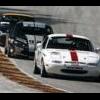
December 2016 Prelims
#121

 Posted 11-11-2016 07:37 PM
Posted 11-11-2016 07:37 PM

- Danny Steyn likes this

#122

 Posted 11-12-2016 06:47 AM
Posted 11-12-2016 06:47 AM

Sorry Danny. Not trying to put words in your mouth. I took "They do still seem to suffer from heat soak on warm days." as more definitive.
No problem Tom. As always, the SMAC encourages drivers to send in data to support their positions.
Copying the submission suggestions from before, and adapting
We encourage ALL NA1.6 drivers to email myself or any of the the SMAC members data AND video from tracks that they run at, so that we can examine the data. Video is required so that we can remove anomalies that occur due to drafting, being skunked, messing up, not getting to WOT before apex, etc.
- Ambient conditions Temp, relative Humidity, Dew Point, wind, sunny, cloudy etc.
- Car and driver weight as weighed after the session
- Track temp
- Camber
- Tires, Age and HC
- Tire pressures cold, tire pressures hot
The more data we get the more it will help us to understand what we might still need to do. Look forward to your contributions.
Danny
Danny Steyn Racing | DSR YouTube Channel
Danny Steyn Photography | Adept Studios | Ocean Machinery | OPM Autosports | Rossini Racing Engines | G-Loc Brakes |
2 x SCCA Runoffs Champ | 1 x NASA National Champ | 6 x June Sprints Champ | 10 x ARRC Champ
1 x SCCA Super Sweep | 2 x Triple Crown | 4 x Hoosier Super Tour Points Champ | 6 x Majors Points Champ | 5 x SEDiv Driver of the Year











#123

 Posted 11-12-2016 09:45 AM
Posted 11-12-2016 09:45 AM

1.6 heat soak is a very interesting point.
When folks say heat soak, what are you really saying?
Maybe the SMAC, Danny or someone else (engine builders) could provide some data that proves heat soak is and what the end result is.
Got to love it when everyone beats around the bush on a definition of 1.6 heat soak.
SMAC members, when your privately discussing 1.6 heat soak, what is your definition of 1.6 heat soak?
Do I need to write a letter to the CRB requesting the SMAC/CRB definition of 1.6 heat soak?



#124

 Posted 11-12-2016 10:13 AM
Posted 11-12-2016 10:13 AM

I'd be interested to hear what SMAC says about heat soak.
My guess is it is underhood temps and intake temp, maybe oil temp, but not water temp.



#125

 Posted 11-12-2016 11:53 AM
Posted 11-12-2016 11:53 AM

I am not speaking on behalf of the SMAC, but I would consider that if a car exhibits a sustained significant departure from the early-lap straightline acceleration data trace in the later laps, then this would probably be an indicator of heat soak. To date, despite looking at a lot of data, I have not seen corroboration of this, but this is what I would look for.
Danny
Danny Steyn Racing | DSR YouTube Channel
Danny Steyn Photography | Adept Studios | Ocean Machinery | OPM Autosports | Rossini Racing Engines | G-Loc Brakes |
2 x SCCA Runoffs Champ | 1 x NASA National Champ | 6 x June Sprints Champ | 10 x ARRC Champ
1 x SCCA Super Sweep | 2 x Triple Crown | 4 x Hoosier Super Tour Points Champ | 6 x Majors Points Champ | 5 x SEDiv Driver of the Year











#126

 Posted 11-12-2016 01:04 PM
Posted 11-12-2016 01:04 PM

Yeah, I think heat soak still exists some, especially in the very hot south east. I think the car is pretty much right where it needs to be in the colder weather though. Clearly, Hille and Rookie help that argument this year.
John Davison
Autotechnik Racing / 5x Racing
2016 - Central Florida Region Champion
2017 - The People's Champion
2017 - President of DSFC
#itcouldbeyou





#127

 Posted 11-12-2016 07:49 PM
Posted 11-12-2016 07:49 PM

- chris haldeman, Danny Steyn and lillyweld like this
K. Webb
Powered by East Street Racing (Best engines in Spec Miata)
Driver coach, Spec Miata Prep shop, Spec Miata Setup
2016 Hard Charger award passing 12 cars runoffs 2016 Mid Ohio
2016 P3 RUNOFFS OVER 40 DIVISION LOL!
2015 First consolation prize Northern Conference Majors Title Pageant
2015 Winner Circus Cat Majors Road America
2015 Winner BlackHawk Majors crash fest
My Signature is still not as long as Danny boy's







#128

 Posted 11-13-2016 09:02 AM
Posted 11-13-2016 09:02 AM

Yeah, I think heat soak still exists some, especially in the very hot south east. I think the car is pretty much right where it needs to be in the colder weather though. Clearly, Hille and Rookie help that argument this year.
Guess what.. It happens in 99 and vvt cars as well in the hot south ![]()
East Street Auto Parts
Jim@Eaststreet.com
800 700 9080













#129

 Posted 11-13-2016 09:25 AM
Posted 11-13-2016 09:25 AM

While my 1.6 is not the fastest out there, i notice that i loose way more when i over heat the tires than i ever do with heat soak. While mid ohio is somewhat of an anomaly, i passed lots of 99's down the back stretch in my self built 1000$ engine with 121HP. I think that its close enough i have decided to drive it one more year and learn my craft, before building a new one. I think my money is better spent with more track time than a new build!
#130

 Posted 11-13-2016 12:16 PM
Posted 11-13-2016 12:16 PM

Guess what.. It happens in 99 and vvt cars as well in the hot south
![]() But Mazda implemented a somewhat solution for the 99 plus cars.
But Mazda implemented a somewhat solution for the 99 plus cars. ![]()
During design of the original MX-5 Miata, an already existing B-series engine was used to power the car. They rotated the engine position by 90 degrees and moved the coolant outlet from back to the front of the engine, resulting in change of coolant flow. Because the coolant inlet and outlet are now both at the front, much less coolant is getting to the rear of the engine, thus less heat is taken away from cylinders at the back. This applies to all models from 1989 to 2005 (first two car generations).
This modification also dropped the efficiency of the whole cooling system. Mazda compensated for it by installing a larger radiator, but this design still struggles under high loads and cylinder 4 runs considerably hotter. This difference in temperatures is measurable and was proven years ago.
Mazda knows about this issue and tried to fix it by changing the head gasket in NBFL (MK2.5) models. This new gasket restricts flow to cylinders 1 and 2, so more coolant is forced to the back. That is why 2001+ cars suffer from the issues mentioned a bit less, but in our opinion restricting the total coolant flow even more is not a proper solution.



#131

 Posted 11-13-2016 04:12 PM
Posted 11-13-2016 04:12 PM

With this definition of heat soak I say the 1.6 does not have any heat soak issue.
As the ambient temp goes up a 1.6 will experience a loss in power- but so will all other cars. The 1.6 may experience a bigger loss but I don't know. What I do know is the cars are very close and all involved got it right! Give the 1.8 a chance and you might see its right too. If it's not then write a letter and send in your data. Until then give the 1.8 a shot.
- Jim Drago, Danny Steyn, Sean - MiataCage and 1 other like this
#132

 Posted 11-13-2016 07:53 PM
Posted 11-13-2016 07:53 PM

Erik, your response is a more eloquent way of stating what we are looking for when we consider data before implementing changes
First we look for the real world consequences. In the case of considering heat soak we would first look for a difference in late-lap acceleration trace vs early-lap acceleration trace
Then we try to ascertain the causes:- is it tire deg that is causing the poor acceleration out the corner, or is it something else, possibly heat soak?
Do we have data that can eliminate the tire deg issue, say data from two separate runs, with roll-on WOT from 50mph in 3rd gear on the same straight, compared to the same at the end of a typical 40 minute session.
If the data supported the heat-soak conclusion then we would look for data to examine IAT and other variables, first at the start of the session and see how it changed over the duration of the session.
And then take it from there
Danny
Danny Steyn Racing | DSR YouTube Channel
Danny Steyn Photography | Adept Studios | Ocean Machinery | OPM Autosports | Rossini Racing Engines | G-Loc Brakes |
2 x SCCA Runoffs Champ | 1 x NASA National Champ | 6 x June Sprints Champ | 10 x ARRC Champ
1 x SCCA Super Sweep | 2 x Triple Crown | 4 x Hoosier Super Tour Points Champ | 6 x Majors Points Champ | 5 x SEDiv Driver of the Year











#133

 Posted 11-17-2016 04:40 PM
Posted 11-17-2016 04:40 PM

While my 1.6 is not the fastest out there, i notice that i loose way more when i over heat the tires than i ever do with heat soak. While mid ohio is somewhat of an anomaly, i passed lots of 99's down the back stretch in my self built 1000$ engine with 121HP. I think that its close enough i have decided to drive it one more year and learn my craft, before building a new one. I think my money is better spent with more track time than a new build!
YAY!!!!!

#134

 Posted 11-17-2016 07:20 PM
Posted 11-17-2016 07:20 PM

I view heat soak as: an increase in tempature (in this case intake air temp) from one lap to the next with all other factors equal. This is what I showed last year in my letter with data that was approved to remove the turn indicator. The data from last year and this year still shows the same thing - when you remove the turn indicator the intake air temp ( measured at the afm) goes down to close to ambient and does not change as a race goes on.
With this definition of heat soak I say the 1.6 does not have any heat soak issue.
As the ambient temp goes up a 1.6 will experience a loss in power- but so will all other cars. The 1.6 may experience a bigger loss but I don't know. What I do know is the cars are very close and all involved got it right! Give the 1.8 a chance and you might see its right too. If it's not then write a letter and send in your data. Until then give the 1.8 a shot.
Can you recommend an air intake sensor kit? Apparently I need to go through the motions to get the 1.8 the turn signal removal.



#135

 Posted 11-17-2016 07:40 PM
Posted 11-17-2016 07:40 PM

Can you recommend an air intake sensor kit? Apparently I need to go through the motions to get the 1.8 the turn signal removal.
WTF is an air intake sensor kit??? Do you mean a thermocouple and gauge to read intake air temperature??? Do you mean an AF ratio gauge with exhaust sensor???
How come no one wants to discuss a real issue or two with heat soak. For my 2 cents worth bringing in ambient air and wrapping the snorkel tube does not eliminate heat soak of the engine.



#136

 Posted 11-17-2016 08:06 PM
Posted 11-17-2016 08:06 PM

WTF is an air intake sensor kit??? Do you mean a thermocouple and gauge to read intake air temperature??? Do you mean an AF ratio gauge with exhaust sensor???
How come no one wants to discuss a real issue or two with heat soak. For my 2 cents worth bringing in ambient air and wrapping the snorkel tube does not eliminate heat soak of the engine.
Dave I've given this some thought and feel that the NA 1.8 and all the NB's probably suffer similarly with heat soak. The only data I would have to back that up is what I've seen on the dyno for the 3 SM cars I've owned (NA1.8, 00 and '01). Each displays a similar pattern of generating less power during initial pulls, best power for a period of time after warm-up and a drop off of power after more pulls. This I see even when keeping water temp stable throughout a dyno session. Not being familiar with a 1.6 I can't comment on that but obviously the turn signal change for that car was done to address an intake air temp issue, or it was done to help the car make a bit more power over the course of a race or for both reasons.
I think a case can be made that all of the cars experience heat soak on the track which to me makes them "equal" in that regard.
- chris haldeman and Danny Steyn like this




#137

 Posted 11-18-2016 07:22 AM
Posted 11-18-2016 07:22 AM

I think a case can be made that all of the cars experience heat soak on the track which to me makes them "equal" in that regard.
We agree some what, but please read copied info below, some engines have an OEM improvement, BUT not the NA.
Several aftermarket folks (those that sell the re route kit) understand the engine overheat issue the same as Mazda does along with many of you. To make Mazda feel good, this re route can be accomplished 100% using the existing 1.6 Mazda OEM parts, including keeping the thermo sensor before the thermostat. I haven't looked at the 1999-2005 cooling systems. There are two Mazda folks on the SMAC, they surly 100% understand the engine overheat issue and the end result of the over heat. The engine was transferred from the Mazda 323/323 GTX where it was mounted longitudinally. If I were a bettor may it be suggested some 1.6's may have massaged existing head gaskets or may have brand new custom head gaskets.
Copied information and not from our President elect. ![]()
Did you know that when driven hard, MX-5 engines suffer from cylinder 4 overheating?
During design of the original MX-5 Miata, an already existing B-series engine was used to power the car. They rotated the engine position by 90 degrees and moved the coolant outlet from back to the front of the engine, resulting in change of coolant flow. Because the coolant inlet and outlet are now both at the front, much less coolant is getting to the rear of the engine, thus less heat is taken away from cylinders at the back. This applies to all models from 1989 to 2005 (first two car generations). This modification also dropped the efficiency of the whole cooling system.
Mazda compensated for it by installing a larger radiator, but this design still struggles under high loads and cylinder 4 runs considerably hotter. This difference in temperatures is measurable and was proven years ago. Mazda knows about this issue and tried to fix it by changing the head gasket in NBFL (MK2.5) models. This new gasket restricts flow to cylinders 1 and 2, so more coolant is forced to the back. That is why 2001+ cars suffer from the issues mentioned a bit less, but in our opinion restricting the total coolant flow even more is not a proper solution. Coolant reroute is moving the front coolant outlet back to the rear and restoring the original engine design.



#138

 Posted 11-18-2016 08:02 AM
Posted 11-18-2016 08:02 AM

We agree some what, but please read copied info below, some engines have an OEM improvement, BUT not the NA.
Several aftermarket folks (those that sell the re route kit) understand the engine overheat issue the same as Mazda does along with many of you. To make Mazda feel good, this re route can be accomplished 100% using the existing 1.6 Mazda OEM parts, including keeping the thermo sensor before the thermostat. I haven't looked at the 1999-2005 cooling systems. There are two Mazda folks on the SMAC, they surly 100% understand the engine overheat issue and the end result of the over heat. The engine was transferred from the Mazda 323/323 GTX where it was mounted longitudinally. If I were a bettor may it be suggested some 1.6's may have massaged existing head gaskets or may have brand new custom head gaskets.
Copied information and not from our President elect.
Did you know that when driven hard, MX-5 engines suffer from cylinder 4 overheating?
During design of the original MX-5 Miata, an already existing B-series engine was used to power the car. They rotated the engine position by 90 degrees and moved the coolant outlet from back to the front of the engine, resulting in change of coolant flow. Because the coolant inlet and outlet are now both at the front, much less coolant is getting to the rear of the engine, thus less heat is taken away from cylinders at the back. This applies to all models from 1989 to 2005 (first two car generations). This modification also dropped the efficiency of the whole cooling system.
Mazda compensated for it by installing a larger radiator, but this design still struggles under high loads and cylinder 4 runs considerably hotter. This difference in temperatures is measurable and was proven years ago. Mazda knows about this issue and tried to fix it by changing the head gasket in NBFL (MK2.5) models. This new gasket restricts flow to cylinders 1 and 2, so more coolant is forced to the back. That is why 2001+ cars suffer from the issues mentioned a bit less, but in our opinion restricting the total coolant flow even more is not a proper solution. Coolant reroute is moving the front coolant outlet back to the rear and restoring the original engine design.
Dave, My Dad was a racer and not a terribly technical guy. He'd jump in the car and go and win. His closest racer friends were engineers, really smart guys with a lot of engineering experience. My Dad loved a good debate and when his engineering friends would dazzle him with details, my Dad would often respond "you know, you're full of little known facts of little interest". Now I'm not saying this of you, Dave but if my Dad was still around and on this forum....he might have replied with that ![]() .
.
Luv ya ![]()




#139

 Posted 11-18-2016 09:55 AM
Posted 11-18-2016 09:55 AM

"you know, you're full of little known facts of little interest". Now I'm not saying this of you, Dave but if my Dad was still around and on this forum....he might have replied with that
.
Luv ya
But, But Tom or anyone else, some of us are interested in continuous learning. I'll suggest my understanding of the thermo sensor which sends signals to the ECU. Water temperature heat impacts the signals the thermos sensor sends to the ECU. The ECU does many things two of which are the fuel control and timing. The thermos sensor through it's heat changing resistance values send different signals to the ECU. The ECU looks at tables and changes the fuel control and the timing. There's a question here. Being the sensor calibration curve and ECU tables curves are arithmetic does the fuel control change less than ideal and does the timing change to less than ideal when the thermos sensor sends a signal to the ECU of a decreased value than the FSM indicates. The FSM indicates decreasing resistance values as the temperature changes from -4*F to 68* F to 176*F. Is the 176*F the maximum temperature the thermos sensor is capable of reading with the minimum resistance value of .29-.35 being sent to the ECU, or if the temperature is 200* F does the thermos sensor send a resistance value of less than .29-.35 to the ECU changing the fuel control and timing more than ideal.
If the message is to tongue twisted to understand please pm and I'll happily enjoy discussion in the interest of learning. ![]()



#140

 Posted 11-18-2016 11:48 AM
Posted 11-18-2016 11:48 AM

Isn't this an updated example of the engineering over all other considerations approach that produces rules creep?
But, But Tom or anyone else, some of us are interested in continuous learning. I'll suggest my understanding of the thermo sensor which sends signals to the ECU. Water temperature heat impacts the signals the thermos sensor sends to the ECU. The ECU does many things two of which are the fuel control and timing. The thermos sensor through it's heat changing resistance values send different signals to the ECU. The ECU looks at tables and changes the fuel control and the timing. There's a question here. Being the sensor calibration curve and ECU tables curves are arithmetic does the fuel control change less than ideal and does the timing change to less than ideal when the thermos sensor sends a signal to the ECU of a decreased value than the FSM indicates. The FSM indicates decreasing resistance values as the temperature changes from -4*F to 68* F to 176*F. Is the 176*F the maximum temperature the thermos sensor is capable of reading with the minimum resistance value of .29-.35 being sent to the ECU, or if the temperature is 200* F does the thermos sensor send a resistance value of less than .29-.35 to the ECU changing the fuel control and timing more than ideal.
If the message is to tongue twisted to understand please pm and I'll happily enjoy discussion in the interest of learning.

0 user(s) are reading this topic
0 members, 0 guests, 0 anonymous users




 Sign In
Sign In Create Account
Create Account



 Back to top
Back to top Report
Report









